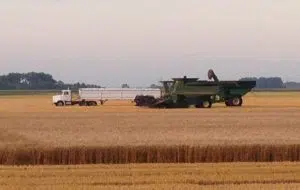
(North Dakota Monitor) — Some wheat fields in North Dakota are showing the potential for 100 bushel per acre yields with the overall crop a potential record-setter.
The annual Wheat Quality Council tour wrapped up Thursday in Fargo after participants spent three days criss-crossing the state to inspect fields and estimate yields.
“The yields could definitely be a record-breaker,” National Wheat Foundation director Brian Walker said after estimates were tabulated.
The North Dakota Monitor said that the average yield came in at 54.5 bushels per acre for spring wheat.

In a July 12 report, the U.S. Department of Agriculture estimated North Dakota spring wheat yields at 56 bushels per acre, up 7.5 bushels from 2023 and a record high if realized.
North Dakota is the nation’s largest producer of spring wheat.
North Dakota spring wheat production was projected to be up 14% from last year, according to the USDA’s National Agricultural Statistics Service, with 1% fewer acres planted to wheat.
Last year, the tour predicted an average yield of 47.4 bushels per acre.
Charlie Rohde of Langdon noted that the tour only estimates “the wheat left standing,” and that there are a lot of low areas where crops were drowned out during a wet spring.
But he was still impressed by the crop in his area that will be harvested in the coming weeks.
“There’s a lot of 100 bushel wheat around,” Rohde said.
Anne Osborne of the National Wheat Foundation, who lives at Sibley, near Valley City, said the northeast corner of North Dakota that was toured had the best-looking fields in the state.
She said there was some evidence of the wet spring with the presence of scab, a fungus that can affect quality.
The highest estimated yield from the tour actually came from northwest Minnesota’s Polk County. Ralph Loos of U.S. Wheat Associates said the 109 bushels per acre estimate on that field was “conservative.”
“We saw a lot of good wheat today,” Loos said.
Loos was visiting North Dakota from Washington, D.C., to take part in the tour. The tour brings in a mix of professionals from the agriculture, the milling and baking industry, journalists and others. Participants get a lesson on how to estimate yields based on a small sample of the field.

Starting Tuesday, tour participants fanned out across North Dakota and western Minnesota to estimate yields and gathered at the end of the day to compare notes.
Samples are averaged for each field and compiled for an overall average.
There are other educational stops, such as a tour of the North Dakota Mill and Elevator in Grand Forks.
Dave Green of the Wheat Quality Council organizes the annual spring wheat tour and a similar winter tour in Southern Plains.
“You’re not going to remember any of these wheat fields in 10 years,” Green said at the end of the tour. “I guarantee that you will remember that you went through the North Dakota Mill and what it looks like and how exciting it was.”










